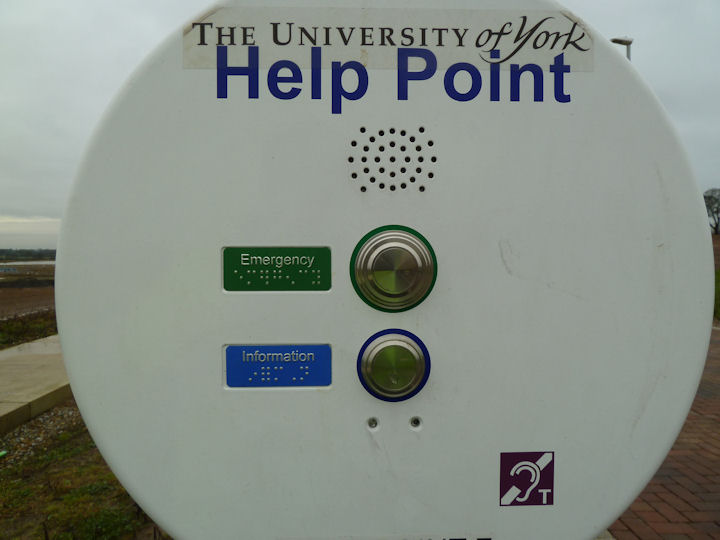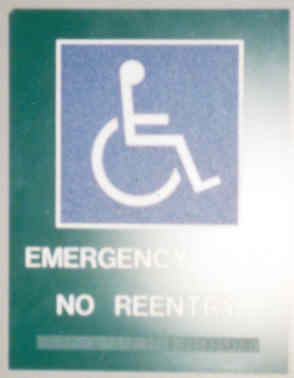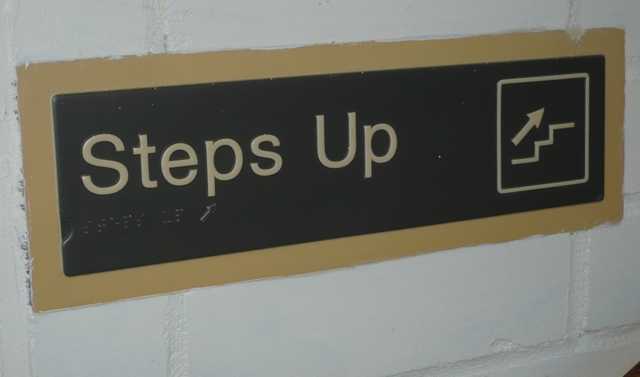 D
DHave you noticed increasing amounts of braille in public places? I have - particularly in the USA. This might seem to be a positive development in terms of the safety and independence of blind people. However, I believe that in many cases it is at best a poorly thought-out gesture and at worst cynical tokenism. A visual sign and a braille one are not equivalent, for several reasons:
I first started thinking about this in the particular case of braille in lifts
(elevators), which led to the following publication:
Edwards, A. D. N. (1998). Making elevators truly accessible to blind people.
Elevator World, December, pp. 34-35.
Since then I have decided to collect instances of such mis-use of braille
This one is from my own university. In case of needing help or in an emergency when there is not a porter around, you can press the appropriate button and speak to a porter. The buttons are clearly labelled, including braille.
But
These points are almost in the middle of nowhere. How is the blind person supposed to know it is there, before they can even start fondling it to find the braille?
 The picture below was taken in Seattle. Glare on the picture makes the text
a bit difficult to read, but under the disability symbol it reads 'EMERGENCY
EXIT. NO REENTRY' and under that is the same in braille I am left with a mental
picture of the building being on fire and a blind person wandering around feeling
the walls in the hope of finding a sign for the exit.
The picture below was taken in Seattle. Glare on the picture makes the text
a bit difficult to read, but under the disability symbol it reads 'EMERGENCY
EXIT. NO REENTRY' and under that is the same in braille I am left with a mental
picture of the building being on fire and a blind person wandering around feeling
the walls in the hope of finding a sign for the exit.
This one was spotted in St Thomas Airport in the US Virgin Islands. It is a 'No smoking' sign, mounted above the door of a toilet. Standing on tip-toe, I can just about reach the braille on the sign - and hope that no one comes out of the toilet while I am doing so. Once again, I cannot really foresee a blind person wondering if they are allowed to smoke, idly scanning above the toilet door in the hope of finding an appropriate sign.
Spotted in a government building in London. You cannot see it in the photograph,
but the lift call buttons were all installed upside-down. In other words, the
button with the arrow pointing upwards, had a braille label reading
DOWN
and vice-versa. Surely this is confirmation of the lack of use
of such labels; if any blind person had ever tried to read the labels, they
would soon have let someone know!
This one really annoys me; there is so much wrong with it. This panel is used to control the toilet door. It has presumably been designed for wheelchair accessibility, but misses out on just about every other quality criterion.
Problems:
It is manifestly apparent that this system was never tested with a blind person. A bit of (very poor) braille was tacked on and the designers evidently thought they had fulfilled their obligations to blind customers.
What would be better? How about:
A conventional door lock is highly accessible. It is easy to check whether it is operating - including a non-visual check (i.e. tug the door and see if it opens!).
It might be conceded that conventional locks benefit from their very familiarity which affords correct operation. If all (or most) door locks in the future operate like the one on the train then it might then be seen as a good affordance.
Also, which of the above locks is more likely to develop a fault? And if one does, which is going to be easier to repair or replace?
This is another good one, on an internal door on another train. It invites you to touch the sensor on the left to open the door. However, if you move your hand anywhere near the sign to read the braille, guess what - the sensor detects your hand and the door opens. At best, the sign you were about to read is whipped away; at worst your hand gets caught in the door mechanism.
Signs in the toilet on a ScotRail train. There are three buttons with labels (in print and Braille). The first says Push to Lock Door When Lit and the others are similar. Braille signs. For people who cannot see. Cannot see whether a button is lit or not - Right?

Which seems more likely, that the blind person will notice the steps when they touch it with their white cane or when their guide dog starts to climb them - or that they will walk down the corridor with their hands on the wall, in hope of encountering this warning sign?
Also, this was the only instance of this sign that I noticed. How were blind people expected to cope with the other stairs?
.jpg) D
D
This is an interesting one; it looks like braille, it feels like braille -
but it is not braille. It is rather closer to gambling. These are the buttons
in a lift for floors 1 to 6, but instead of braille numbers, there are dots
as would be seen on a dice. Because the dots are not separated as braille cells
would be, there is no direct interpretation of then, but to a braille-reader
6 resembles ll (two letter Ls); 5 might be read as ok, 4 is kk.
The representation of 3 is too ambiguous to interpret. Two might be read as
ch, and 1 could be any one-dot braille cell.
It seems fortuitous that there were apparently only six floors in this building. What if there were more? Would they be represented by a pair of dice?
This picture was taken in a hotel in Amsterdam, by Helen Petrie.
This was posted on Twitter by @_youhadonejob, who commented 'Someone doesn't understand how braille works'. Indeed, they don't - on different levels. No one is going to read braille through glass - but what about all those people with dirty hands reading the braille to see what to do next?
If the child is so blind that they need braille, then the concept of any kind of reflection is going to be one they will find difficult, and probably not a lot of fun.
My local council, York, provides households with green waste bins in which we can put garden waste – to be recycled into compost. Our bin includes this braille label. Quite apart from the (usual) question as to when a blind person is likely to look for – and find – this label, I am not sure what is is meant to say. The first 4 cells represent the number 180, but what is the last one? 'With'?
Don't get me wrong, I am all in favour of providing facilities which will help all people - including those with visual disabilities - to operate independently in public areas but then I am in favour of providing facilities which will help all people to operate independently in public areas - and these silly notices do not have that effect.
I have ideas as to how this might truly be achieved, and I'd be happy to talk them over with anyone. I had a student project which looked at a particular solution to accessibility in lifts. I wrote this up in:
Edwards, A. D. N. (1998). Making elevators truly accessible to blind people. Elevator World, December: pp. 34-35
By all means mail me (email name: alistair domain: cs.york.ac.uk) if any of this strikes any chords with you.
A Polish artist has created braille graffitti - and why not?!
10 March 2019